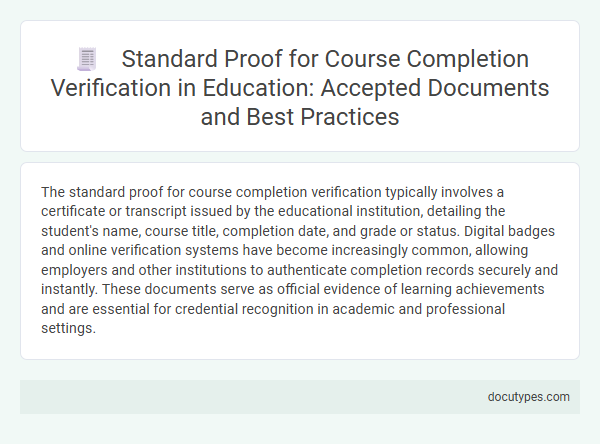The standard proof for course completion verification typically involves a certificate or transcript issued by the educational institution, detailing the student's name, course title, completion date, and grade or status. Digital badges and online verification systems have become increasingly common, allowing employers and other institutions to authenticate completion records securely and instantly. These documents serve as official evidence of learning achievements and are essential for credential recognition in academic and professional settings.
Introduction to Course Completion Verification in Education
| Aspect | Description |
|---|---|
| Definition | Course completion verification is the process of confirming that a student has successfully fulfilled all requirements of an educational program or course. |
| Purpose | It ensures the authenticity of academic achievements and helps institutions, employers, and other stakeholders recognize valid credentials. |
| Standard Proof Types | Official transcripts, completion certificates, digital badges, and accredited verification letters serve as recognized proofs of course completion. |
| Verification Process | Verification typically involves cross-checking student records with institutional databases and may include third-party verification platforms for added security. |
| Importance in Education | Standardized course completion proof maintains academic integrity, supports credit transfers, and aids in career advancement decisions. |
| Technological Integration | Advancements include blockchain-based certificates and secure online portals that streamline verification and prevent fraud. |
Importance of Standardized Proof for Course Completion
What is the standard proof for course completion verification? Standard proof for course completion typically includes a certificate, transcript, or official letter from the educational institution. These documents provide a reliable and standardized method to confirm that a learner has successfully completed the required coursework.
Why is standardized proof for course completion important? Standardized proof ensures consistency and credibility across educational institutions and employers. It helps verify qualifications accurately, supports learner mobility, and enhances trust in the certification process.
Commonly Accepted Documents for Course Completion Verification
The standard proof for course completion verification typically includes official documents issued by the educational institution. Commonly accepted documents are certificates of completion, official transcripts, and letters of verification from course instructors or administrative offices. These documents serve as reliable evidence that the individual has successfully met all course requirements and achieved the necessary learning outcomes.
Official Transcripts: The Gold Standard
Official transcripts serve as the standard proof for course completion verification, providing an authoritative record of your academic achievements. These documents are issued directly by educational institutions and detail the courses completed, grades earned, and credits acquired.
- Authenticity - Official transcripts are securely produced, ensuring the information is accurate and tamper-proof.
- Comprehensive Record - They provide a complete overview of your academic history, including dates, courses, and final grades.
- Widely Accepted - Employers, universities, and credential evaluators recognize official transcripts as the most reliable form of verification.
Requesting your official transcript is essential for validating course completion to third parties.
Course Completion Certificates: Formats and Essentials
Course completion verification is commonly established through standardized course completion certificates issued by educational institutions or online platforms. These certificates typically include essential details such as the learner's name, course title, completion date, and an authorized signature or digital seal to ensure authenticity. Standard formats are designed to be easily verifiable and compatible with various verification systems used by employers and accreditation bodies.
Digital Badges and E-Certificates in Modern Verification
The standard proof for course completion verification typically involves digital badges and e-certificates. These tools provide verifiable and tamper-proof evidence of your achievements in an educational setting.
Digital badges are encoded with metadata that details the issuing institution, criteria met, and date of completion, enhancing credibility. E-certificates offer a formal document that can often be electronically verified through unique identification codes or QR links.
Verification Letters from Educational Institutions
Verification letters from educational institutions serve as the standard proof for course completion verification. These official documents confirm a student's successful completion of a course or program and are widely accepted by employers and other academic entities.
- Official Confirmation - Verification letters provide authenticated proof issued directly by the institution that a student has fulfilled all course requirements.
- Detailed Information - The letters typically include the student's name, course title, completion date, and sometimes grades or honors achieved.
- Widely Recognized - Employers, certification bodies, and educational institutions accept these letters as valid evidence of academic achievement and course completion.
Best Practices for Document Authentication
Standard proof for course completion verification ensures the authenticity and recognition of educational achievements. Best practices for document authentication help maintain trust and credibility in academic credentials.
- Official Transcripts - Issued directly by the educational institution, transcripts list completed courses and grades to verify completion.
- Digital Certificates - Secure, tamper-proof digital certificates use encryption and blockchain technology to confirm course completion.
- Institutional Seals and Signatures - Physical or electronic seals and authorized signatures authenticate documents and prevent forgery, securing Your verification process.
Preventing Fraud in Course Completion Verification
Standard proof for course completion verification typically includes digital certificates, transcript records, and unique verification codes that confirm a student's achievement. These methods provide a reliable and formal acknowledgment of completion recognized by educational institutions and employers.
Preventing fraud in course completion verification involves the use of secure blockchain technology, encrypted digital certificates, and real-time verification systems. These tools ensure authenticity by making certificates tamper-proof and easily verifiable online. Institutions also implement multi-factor authentication and regular audits to maintain the integrity of the verification process.
What Is the Standard Proof for Course Completion Verification? Infographic

